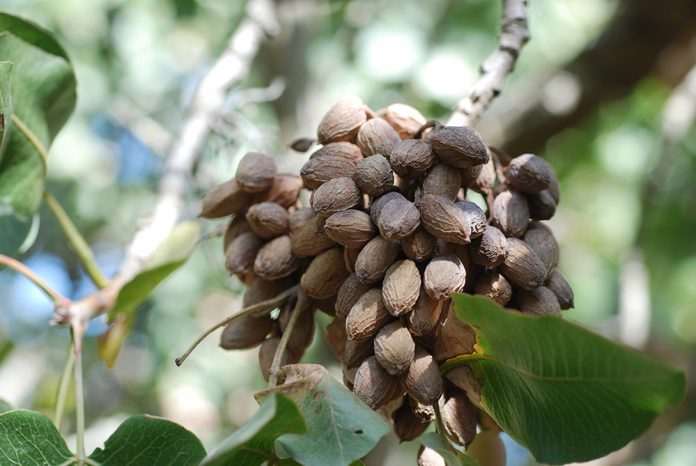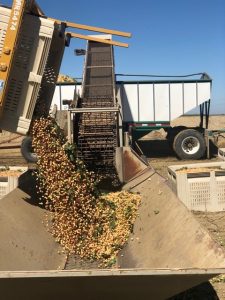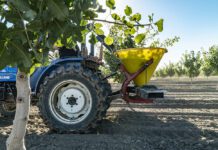
While the San Joaquin Valley still dwarfs acreage in the Sacramento Valley, water and land availability and regulations are driving a further move north for the crop. UCCE Orchard Systems Advisor Kat Jarvis-Shean, during a presentation at the North Valley Nut Conference, shared some unique considerations for growing pistachios in the north state.
The Sustainable Groundwater Management Act is driving concern about water and influencing some of the pistachio planting in the Sacramento Valley while driving acreage out of the San Joaquin Valley, and growers are looking to diversify into pistachio due to its higher per-pound price compared to its almond and walnut counterparts.
Additionally, according to Jarvis-Shean, pistachios “eat boron for breakfast,” allowing growers a better opportunity to grow the tree nut in high-boron areas like Yolo County where other perennial crops don’t fare as well.
Jarvis-Shean spoke to growers and consultants from the Sacramento Valley about pistachio production in the area and differences (some favorable) compared to that growing in the San Joaquin Valley. The biggest ones, she noted, include temperature, precipitation, soil texture, cropping history and proximity to industry resources.
Lower Max Temps
Average maximum temperatures are lower in the Sacramento Valley compared to the San Joaquin Valley, but this acts as a sort of disadvantage to pistachio. These lower temperatures, according to Jarvis-Shean, impact ‘growing degree hours’, and the lower these hours are, the fewer splits will be observed in an orchard.
The way this works, she said, is based the nut’s growth physiology. The shell grows first, then the shell hardens, then the kernel grows, wedging the shell open, all based on how much heat the nuts have accumulated throughout the season. Therefore, lower average heat units in the Sacramento Valley mean a higher percentage of total closed nuts, and more closed nuts means less return at the processor.
Lower splits will happen in the Sac Valley regardless, but there are ways to counter this issue, according to Jarvis-Shean. If planting pistachios in the Sacramento Valley, she recommends first thinking about where the property is being purchased.
“There are ‘hot’ spots regionally around here,” Jarvis-Shean said. “This is one of the reasons that the Arbuckle district worked really well for pistachios for a while.”
Additionally, she said, growers can choose cultivars that are pre-disposed to getting more splits, like Golden Hills (as opposed to Kerman.) “If you know you’re going to take a few licks in terms of shell splits, at least start with a higher percentage,” Jarvis-Shean said.
She also stressed the need to prepare for future freeze events in the Sacramento Valley, which are more prone than the San Joaquin Valley. In recent years, walnut growers (and almond and pistachio growers to a lesser degree) have been “viscerally” affected by freeze events, according to Jarvis-Shean, which kill upper-canopy branches. Keeping irrigation lower prior to a freeze event is recommended.

Average Precipitation Higher
Davis and Durham are two areas in the Sacramento Valley where pistachio production is growing. Comparing these areas to Firebaugh and Belridge in the San Joaquin Valley, the difference in average precipitation is substantial; thus, there is a difference in evapotranspiration levels. Taking both precipitation and evapotranspiration into consideration, these Sacramento Valley growing areas have the San Joaquin Valley areas beat by more than double the inches per season.
“Precipitation total we really have in our favor,” Jarvis-Shean said. “That’s one of the great things about growing pistachios up here and growing in general; we don’t need to pump as much water to be able to irrigate our system.
While higher average precipitation in the Sacramento Valley is beneficial for agriculture, there are issues to consider with the difference in precipitation compared to that of the San Joaquin Valley.
When planning a pistachio program, Jarvis-Shean said to be aware of fungal diseases like Botryosphaeria that can present themselves more easily in April through June due to higher precipitation levels.

Varying Soil Textures
“We generally have heavier soils in the Sac Valley than in the San Joaquin,” Jarvis-Shean said.
Heavier vertisol soils are more common in the north state, creating implications for drainage and root health, especially when paired with the region’s tendency for higher average precipitation.
Jarvis-Shean noted that pistachio growers don’t have as many tools in the toolbox when it comes to rootstocks dealing with heavier soils. “You need to manage and set up your whole orchard from the beginning knowing that your rootstocks are not going to like saturated conditions.
“Think about berms, think about increasing your organic matter from the beginning,” she added.
Cropping History
Taking cropping history into account when planting a new pistachio orchard is important. The Sacramento Valley has historically grown tomatoes, for example, in many areas, and when these annuals get ripped out, they leave behind Verticillium and other diseases that may transfer over to the perennial replacement, according to Jarvis-Shean.
“With our UCB rootstocks now they seem to be doing a lot better with following tomatoes,” she said.
Proximity to Industry Resources
Until a pistachio processing facility is created in the Sacramento Valley, growers will have to commit to trucking nuts down promptly after harvest for processing in existing San Joaquin Valley facilities.
“That needs to happen in pretty quick order so that the skin on the outside of the nut’s shell doesn’t stain the shell and cost you in quality numbers,” Jarvis-Shean said, noting that she’d be “astonished” if there is not a pistachio processing facility in the Sacramento Valley in the next five years due to increasing acreage.
If trucking appointments aren’t secured earlier in the season before harvest, pistachio growers will likely have a logistical nightmare on their hands come harvest.











